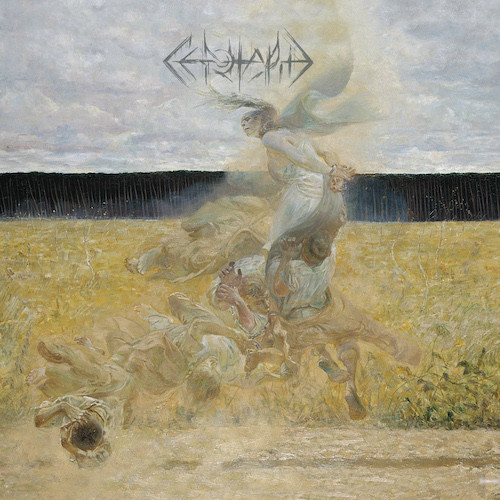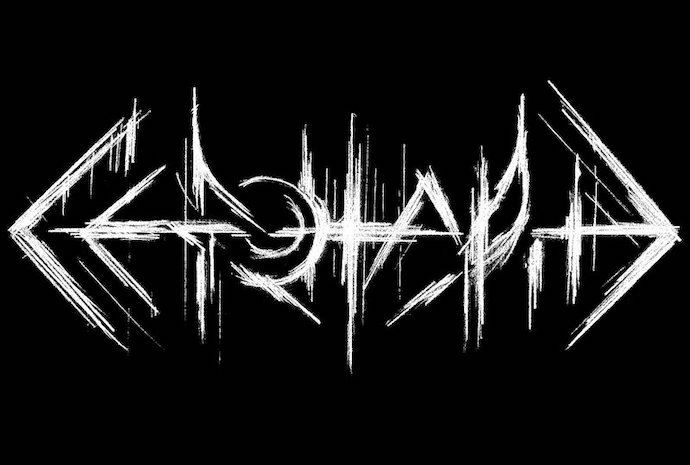When we encounter new music, it is the quality of the compositions and performances that always comes first, and remains paramount, but when a new release has been conceived and crafted with a deep guiding aesthetic that permeates the spirit of the music and the lyrics in a heartfelt way, especially when that aesthetic is an unusual one, it inspires even greater admiration. That’s what we have before us in Empyrée, the superb new EP by the French black metal duo Cénotaphe (multi-instrumentalist Fog and vocalist Khaosgott).
We have learned that in creating this new work, Cénotaphe drew inspiration from “a constellation of 19th-century French literary and artistic figures, such as Aloysius Bertrand, Théophile Gautier, Charles Beaudelaire, and the painter Odilon Redon,” but most especially from the poetry of Stéphane Mallarmé. As I am unfamiliar with Mallarmé’s writing, I’ll quote from the press materials announcing this new EP:
“Mallarmé’s work is dense with inscrutable and tangled syntax, every poem an arcane cipher; however, despite his modern and unconventional style, Mallarmé tended to rely on stalwart and traditional poetic forms, like the sonnet. Within the framework of these rigid poetic structures, Mallarmé’s language was itself unconstrained, abstract, exquisitely lawless, but also excruciatingly methodical and intentional”.
Remember that description as you listen to the six songs on this substantial EP (which reaches a length of more than 33 minutes), an opportunity we’re presenting today through the premiere stream of Empyrée in its entirety, before it’s released on February 15th by Nuclear War Now! Productions.
These six compositions have clearly been crafted with great care, meticulously designed in the way they unfurl within the senses, and as promised in the press materials, they “remain true to the form and spirit of black metal”, yet there is also much about this music that is gloriously unconstrained.
Apart from the pure excitement of the drumming and the scalding intensity of the principal vocals (which range from savage howls to mind-flensing cries and fervent proclamations), the gripping melodies and carefully chosen instrumental accents make these songs stand out. The driving energy of the music is near-relentless, yet those melodies cause the moods of the music to change in subtle but unmistakable ways. And so, even within discrete songs, the sounds are explosively vibrant and wondrously mystical and majestic, as well as solemnly reverent, and they’re also capable of casting a pall of anguished hopelessness and inconsolable misery.
The opener “Centaures” swoops in like raptor, catches up the listener in its flashing claws, and sweeps us up in its exultant flight, carried away by a mix of blasting, bounding, and thundering drums, and by blazing tremolo riffs that are bright and shining but become roiling, cold, and cruel, as well as frenzied in a way that channels the flames of anguish.
That full-throttle rush continues in “Au sépulcre des astres” with fierce riffs that fly high, but here you’ll encounter reverent choral vocals as well as a change to a slow stalking gait and a more desolate melody. Still, there are bright streams of glistening ambience in the song, and it eventually becomes a majestic march.
Cénotaphe make great use of keyboards across the EP — they’re never overbearing, yet they’re vital to music’s overall impact. Having said that, “Face aux feux d’un soleil porphyré” is a largely instrumental composition for its first half, which is a long sequence of eerie, haunting ambient tonalities that lead into gloomy yet magisterial organ chords which sound as if they’re resounding beneath a cathedral vault, as accompaniment to solemn chanting. This makes for a moody and mystical break in the flow of the EP — which resumes in the song’s second half as the music surges into a head-moving charge of deep, drilling riffs, low humming bass, and high, flourishing leads.
Blasting and racing, “Inanité des noirs mensonges” manages to combine sensations of both euphoria and emotional desolation, accented by a keyboard layer that adds a haunting, panoramic quality to the sound, while “Même mort, il brûle” is at least equally thrilling (again embellished with wordless choral vocals and a glorious keyboard layer).
The EP closes in an interesting way, with a largely instrumental cover of “End of the World” by the 1960s Greek prog pioneers Aphrodite’s Child (the first band of the renowned Vangelis). Unsurprisingly, of course, Cénotaphe put their own stamp on the music. As another kind of break in the EP’s pacing, this cover begins with an ambient intro that shines with an astral glow, followed by long, heavy, funereal chords delivered at a dirge-like pace, mixed with the contrast of choral voices lifted high in praise and by whistling mystical tones. But Cénotaphe then pick up the pace, sending this remarkable EP off in another high-flying blaze of intensity, lifted even higher by exultant organ chords.
This really is an uncommonly good EP, and one that’s very easy to become captivated by from beginning to end. And to complete the unifying aesthetic of the work, the EP’s cover art is an 1893 piece named “In the Dust Cloud” by the Polish symbolist painter Jacek Malczewski.
To repeat, Empyrée will be released by Nuclear War Now! on the 15th of February — tomorrow! Get on it now.
NUCLEAR WAR NOW!:
https://shop.nwnprod.com/collections/new-arrivals
CÉNOTAPHE:
https://www.facebook.com/lecenotaphe/



That cover art + logo = sick AF.
That would be two in a row French black metal, baby!
I had the same thought — first Véhémence and now this. Back-to-back home runs.
Fog, one the two guys behind Cénotaphe, was member of a too much under-rated band (now splitted) ANGMAR : especially check “Zurück in die Unterwelt” and an EP of previously unpublished tracks so called “Cénotaphe” (!). I’m not sure you have written about at NCS. Nobody’s perfect (although I’ve thought so so far 😉
https://www.youtube.com/watch?v=1UCBidS-d1o
https://legionofdeathrecords.bandcamp.com/album/c-notaphe-lost-tracks
You are correct that we never wrote about Angmar, although that name does ring a bell with me. Thanks for those links, it will be interesting to see what Fog did in that other project. I knew that the members of Cénotaphe have been involved in other bands, but I didn’t research to find out what they were (and should have).
Don’t blame yourself, it’s quite impossible to thoroughly scan and absorb the entire metal galaxy.
Truer words were never spoken. It’s an enormous galaxy, and ever-expanding.